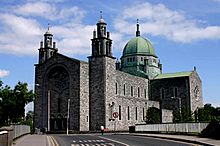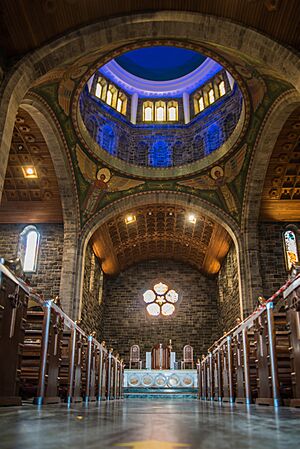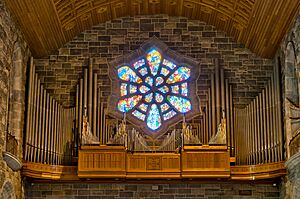Cathedral of Our Lady Assumed into Heaven and St Nicholas, Galway facts for kids
Quick facts for kids Galway Cathedral |
|
|---|---|
| Cathedral of Our Lady Assumed into Heaven and St Nicholas | |
 |
|
| 53°16′31″N 9°03′27″W / 53.27528°N 9.05750°W | |
| Location | Gaol Road, Galway |
| Country | Ireland |
| Language(s) | English, Irish |
| Denomination | Roman Catholic |
| Tradition | Roman Rite |
| History | |
| Dedication | Our Lady Assumed into Heaven and Nicholas of Myra |
| Consecrated | 15 August 1965 |
| Architecture | |
| Style | Renaissance Revival |
| Groundbreaking | 1958 |
| Completed | 1965 |
| Administration | |
| Archdiocese | Tuam |
| Diocese | Galway and Kilmacduagh |
| Province | Ecclesiastical Province of Tuam |
The Cathedral of Our Lady Assumed into Heaven and St Nicholas is often called Galway Cathedral. It is a large Roman Catholic church in Galway, Ireland.
Building the cathedral started in 1958. It was built on the site of an old city prison. The cathedral was finished in 1965. It is known as "the last great stone cathedral to be built in Europe." It was named after Our Lady Assumed into Heaven and St. Nicholas.
Contents
History of Galway Cathedral
Before the current cathedral, there was a smaller church. Around 1750, a chapel was built on Middle Street. In 1821, this chapel was replaced by a new church. This new church was made of limestone and built in the Gothic style. It was dedicated to St. Patrick.
When the Diocese of Galway was created in 1831, St. Patrick's Church became the main church, called a pro-cathedral. After Galway Cathedral opened in 1965, St. Patrick's was no longer used as a church.
Opening Day of the Cathedral
Galway Cathedral officially opened on 15 August 1965. The President of Ireland, Éamon de Valera, lit a special candle. Cardinal Richard Cushing from Boston gave a speech. Bishop Michael Browne of Galway led the ceremony. Four Archbishops also joined him on the altar.
Architecture and Design
The architect who designed Galway Cathedral was John J. Robinson. He had designed many other churches in Ireland. The cathedral's design mixes different styles. Its large dome and tall pillars look like Renaissance style buildings. Other parts, like the rose windows and mosaics, show older Christian art styles.
The dome of the cathedral is very tall, reaching 44.2 meters (145 feet). It stands out in the city's skyline. Most of the cathedral is built from local limestone. It is thought to be the last large public building in Ireland made almost entirely of stone.
Some people wanted a modern-looking cathedral in the 1950s style. However, the church leaders wanted a more traditional building. In 1966, a student called Brian Trevaskis said the building was a "ghastly monstrosity" on a TV show. More recently, an article in The Irish Times called it a "squatting Frankenstein's monster."
Church Services
Mass is held every day at Galway Cathedral. On Saturday evenings, there is a special Mass at 6 PM. On Sundays, Masses are at 9 AM (in Irish), 10:30 AM, 12:30 PM, and 6 PM. On weekdays and holy days, Mass is celebrated at 11 AM and 6 PM.
Music at the Cathedral
Music is an important part of the services at Galway Cathedral.
Cathedral Choir
An adult choir has been part of the cathedral since it opened. The choir sings at all major ceremonies and at the regular Sunday 10:30 AM Mass. They perform many types of music. This includes music from the 16th century to today. They also sing Gregorian chant and traditional Irish music.
Cathedral Organs
The main pipe organ was built in 1966 by a company from Liverpool. Between 2006 and 2007, an Irish organ builder named Trevor Crowe made it much bigger and better. This organ has three keyboards and 59 different sounds. It is used often during services and for summer concerts.
The cathedral also has a smaller, portable organ. It has one keyboard and four sounds. This smaller organ is used for services in the cathedral's side chapels. It also helps with music in concerts.
Burials
Several important people are buried at Galway Cathedral. These include:
- Michael Browne
- Eamonn Casey
- James McLoughlin
- Thomas O'Dea
- Thomas O'Doherty
Images for kids
See also
 In Spanish: Catedral de Nuestra Señora de la Asunción y San Nicolás (Galway) para niños
In Spanish: Catedral de Nuestra Señora de la Asunción y San Nicolás (Galway) para niños












